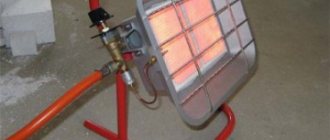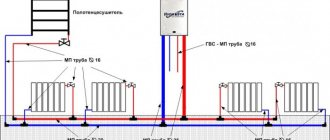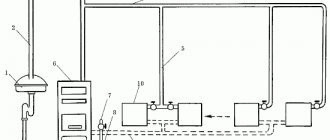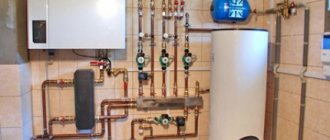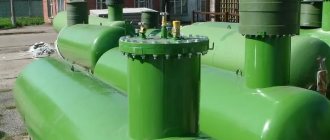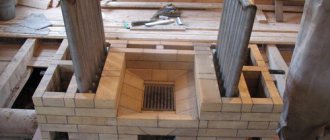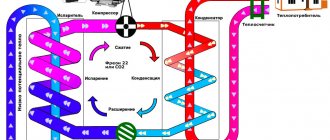Which furnace gas industry will accept without complaints: 11 recommendations to avoid problems with connection
Why is the boiler room actually a furnace room, how to design it and what to equip it with
Heating the house from the main house is the cherished dream of many country residents. The “heart” of such a home is the room where the gas boiler is installed. What requirements do gas services place on a boiler room? And how to design a furnace so that it is approved by the gas industry? We have selected key recommendations from the new Code of Practice and will tell you about them in this material.
What materials and equipment should be in the furnace room?
Everything is written in the Code of Rules:
- The wall-mounted gas boiler in the combustion chamber must be located at least 20 mm from the walls (back and side) made of fireproof materials.
- Walls made of non-combustible materials must additionally be insulated with non-combustible materials that do not support combustion and the spread of flame. In this case, the boiler is located at a distance of 30 mm from the wall. The insulation should extend beyond the dimensions of the equipment by 100 mm on the sides and 0.7 m on top.
- If a gas boiler is placed on a wooden floor, it must be insulated with fireproof materials. The fire resistance limit of the material is at least 45 minutes. The floor insulation must protrude beyond the dimensions of the equipment body by at least 100 mm. Install the equipment in the furnace so that there is easy access to it for operation and repair.
How should a furnace room with a gas boiler be ventilated?
The dimensions of the exhaust and supply channels are determined by calculation based on the following parameters:
- Ventilation of the combustion chamber occurs naturally.
- The hood should provide three air exchanges in the room in 1 hour.
- The inflow is equal to the exhaust volume + the air required for gas combustion.
In which direction should the door from the furnace open?
The door from the room where the gas boiler is installed must open outward.
What size window should be installed in the furnace room?
The window in the furnace room is made on the basis that the glazing area, and not the entire window with frame, is at least 0.03 square meters. m per 1 cubic meter of room volume. Moreover, the window design must meet the requirements set out in GOST R 56288 “Easily removable window structures with double-glazed windows for buildings”
. In short, the window, in the event of a gas explosion in the furnace and exposure to a blast wave, must, under the influence of pressure, open outward. For example, a sash rotates around its axis, or a double-glazed window, or a frame with a double-glazed window moves and falls out.
Where should gas boilers not be placed?
It is not allowed to install gas-using equipment in bathrooms and toilets.
Is it possible to install a gas boiler in the basement?
First, let's define the terms: “basement” and “ground floor.” So,
- Basement floor
- a floor where the floor level of the premises is below the planning level of the ground by no more than half the height of the room. - Basement floor
- a floor where the floor level of the premises is below the planning level of the ground by more than half the height of the room.
SP 402.1325800.2018 states that heat generators running on natural gas can be placed in the basement and basement floors of residential buildings.
Is it possible to install a gas boiler in the kitchen if there is already a gas stove there?
In the kitchen, you can install a gas stove, and hang a modern gas boiler on the wall, for example, a condensing boiler, which goes well with low-temperature heating systems - liquid heated floors. But there are a number of important limitations:
- If the kitchen has a two-burner gas stove and a gas boiler with a closed combustion chamber
, the volume of the room must be at least 8 m³, with a ceiling height of at least 2.2 m. - If a four-burner gas stove is installed in the kitchen, you must admit, this is what is done in most cases, and a gas boiler with a closed combustion chamber is installed, then the volume of the room must be at least 15 m³.
- If there is a gas stove in the kitchen and a gas boiler with an open combustion chamber hanging
, then another 6 m³ is added to the above-mentioned room volumes.
The kitchen should be ventilated using an exhaust system through a window with a window. If the kitchen has a door, then a gap of at least 0.02 square meters is made between it and the floor for air flow. m.
The volume of the combustion chamber must be at least 15 m³, right?
SP 402.1325800.2018 contains clause 5.5. In short, it says - the volume of the combustion chamber must be at least 15 m³, with a ceiling height of no less than 2.5 m.
Is it true that a ceiling height of 2.5 m is required for a gas boiler?
Due to changes in SNiPs and Codes of Regulations of different editions and different years, confusion arises as to what the height of the ceilings in the furnace room should be. Let's turn to SP 402.1325800.2018. It states that the ceiling height in a separate room where a gas heat generator is installed must be no less than 2.5 m, provided that the boiler is operated with an open combustion chamber
.
Gas boiler room, boiler room and furnace room, are they the same thing?
Many are accustomed to calling the premises in private residential buildings where gas heat generators are installed - boiler rooms or boiler rooms. This is not entirely correct. A boiler room is, most often, a separate facility where engineering equipment is located, which generates heat for multi-storey residential buildings and complexes, as well as commercial and industrial buildings. Boiler rooms are subject to more stringent requirements than conventional furnaces.
for cottages.
The combustion room is an individual room where there is a gas heat generator that produces heat for a private home.
SP 402.1325800.2018 has the following description: a heat generator room is a separate non-residential premises where a boiler and additional engineering equipment are installed. Therefore, below, we will call the boiler room the furnace room.
Features of installation of floor and wall models
To heat the garage, floor-mounted or wall-mounted gas boilers are used. To place floor models on a pre-leveled surface, it is necessary to build a support platform made of heat-resistant brick or concrete. To make the installation of the boiler even more stable, you can make a small pocket in the floor. There is no need for this if the boiler comes with a special stand for floor mounting.
To install wall-mounted units, the nearest sections of the walls must be finished with fire-resistant material. The stove should be fixed so that its position corresponds to the vertical and horizontal levels. The nearest wall or element of furniture should be at a distance of 30-50 cm from it for fire safety purposes and ease of access.
Connection to water and gas pipelines
Upon completion of all installation work, the boilers are connected to the circulation pipelines. Before doing this, turn off the water supply and prepare the mounting flanges or threaded couplings. To additionally seal the joints, tow is used.
Pipes are connected to floor-standing and wall-mounted boilers in different ways:
- to the first - from above and from the side;
- to the second - from the transverse side.
If necessary, ball valves are installed in areas where coolant is supplied to radiators. If the garage heating is not equipped with an electric pump, then the pipes must be at a slope of up to 5 mm per linear meter, otherwise there will be difficulties with the natural circulation of water in the main.
Piping diagram for a double-circuit gas boiler. Click on photo to enlarge.
After connecting the pipelines, a test run of the system is carried out to check the furnace for operability and make sure that the tightness of the joints is not broken in any area. If necessary, additional sealing is performed.
Requirements for the premises for installing a gas boiler
The premises in which the gas boiler will operate are specified in SNiP 31-02-2001, DBN V.2.5-20-2001, SNiP II-35-76, SNiP 42-01-2002 and SP 41-104-2000 - these documents eliminate or minimize any emergency situations. Premises for placing gas boilers fall under the classification of fire and explosion hazards, therefore, when designing, planning, installing and setting up equipment for gas heating, all requirements for the premises for installing a gas boiler must be strictly observed.
Advantages of gas heating in the garage
- Low cost compared to electricity;
- Economical consumption - to maintain the optimal temperature in the garage you do not need large volumes of fuel;
- Possibility of using gas in cylinders for the installation of autonomous heating;
- Gas is a natural fuel that burns completely and does not release harmful substances into the air.
However, there are certain difficulties when installing gas heating:
- Purchasing the necessary equipment will require a substantial initial investment;
- It is prohibited by law to connect gas installations yourself; for this you will need a specialist;
- There are safety requirements for such equipment that must be met.
General requirements for the installation of gas appliances
In the room intended for the installation of a gas boiler, according to the above standards, there must be good natural lighting: per 1 m 3 there must be at least 0.03 m 2 of window opening area (but not windows - partitions, frames and imposts are not taken into account). It is imperative to equip the room with a supply and exhaust ventilation system according to the following rules: the total volume of forward and reverse air flows per hour, multiplied by 3, is equal to the volume of the entire exhaust device. In addition to a window equipped with a window, a door with access to the street is installed in the room. The table shows the requirements for room volume:
For gas-fired units with a power of more than 6000 W, 0.2 m3 should be added for each extra unit of power.
Supervisory requirements for the premises for installing a gas boiler stipulate that the operation of any appliances for heating an apartment is permitted on each floor of a multi-storey building and in any room of the apartment. Kitchens in multi-storey buildings also meet these requirements, since they are already equipped with appropriate communications. The only condition is that the total thermal power of all devices for heating water and heating the apartment (boilers, boilers, heating elements, heating radiators, batteries or registers) should not exceed a total of 150 kW.
The ceiling height in the room is 2 meters or more. The room in which the gas boiler will be installed and operated must be separated from adjacent rooms by solid fire-resistant walls. Material for walls or partitions must have a fire resistance time limit of 0.75 hours (45 minutes). The boiler room must be designed so that in the event of an operational fire there is no possibility for the fire to spread throughout the apartment.
Gas boilers of the TLO brand, operating on the principle of natural coolant circulation, can be installed and should be operated only in the basement of the house or in the basement.
Installation and connection
Gas is a flammable and explosive substance that should be handled with extreme care. Therefore, the most stringent requirements are imposed on the quality of installation and connection of gas appliances. According to current legislation, such a stove must be equipped exclusively by gas service specialists. Amateur work with gas is not allowed!
Preparation for installation
The room in which the stove will be located must be separated from the rest of the garage. The area of the boiler room must be at least 4 m2 and have a ceiling height of 2 m. In this room, the presence of a door with a width of 80 cm and a properly functioning ventilation duct for the flow of fresh air is regulated. A window should also be provided, which in the absence of electricity can become a source of natural light. The walls of the boiler room should be finished with a material with the lowest possible flammability.
If heaters require the construction of a chimney, then its upper part must be at a height of at least one meter above the level of the garage roof.
The chimney should be constructed in such a way that it has as few bends as possible. This is necessary so that combustion products are discharged outside and do not settle on bends and partitions. To construct chimneys, pipes with a diameter of 130 mm or more are usually used.
The area where the chimney is connected to the garage roof should be reinforced with fire-resistant materials - asbestos cardboard or galvanized steel. Don’t forget about the thermal insulation of the chimney.
Installation of a gas wall-mounted boiler - kitchen requirements
- Ceiling - 2 meters and above.
- The total volume of the kitchen is more than 7.5 m3, ventilation is equipped, a window is installed and there is a door opening onto the balcony.
- For air exchange, it is necessary to install a grille at the bottom of the wall or door that opens into the next room; the area of the grille is at least 0.02 m2.
If the kitchen in the apartment does not meet the requirements of SNiP, then gas heating equipment can be installed and operated only with the permission of the gas supervision authority.
It is strictly forbidden to install more than 2 heating devices or more than 2 boilers in one room if the volume of the room is less than 7.5 m3
The existing rules for installing a gas boiler in a private house largely repeat the requirements for boilers that operate in apartments in multi-storey buildings. The differences are caused only by the fact that often in a private house a separate room or building is allocated for heating equipment, which is subject to additional requirements listed below.
Comparison of heating sources with each other
In winter, the air temperature drops below zero, so it is unpleasant to be inside a garage building without a boiler room.
Heating devices today are manufactured in a wide variety. They differ in their cost, size, and power source, which largely determines the operational parameters of such equipment. Let's talk further about how to add warmth to a garage building. Heating a garage with a boiler is an excellent solution if the room is used all year round. But which equipment option should you prefer?
Today we will consider the following boiler models that are worth choosing:
- gas unit;
- electric boiler for the garage;
- on solid fuel: firewood, coal, construction waste, etc. heaters;
- garage heater that consumes alternative fuel: used engine oil, pallets, biofuel, etc.
Gas is cheap and efficient
Gas is the most economical fuel, provided that the main pipe is close. Otherwise, you will have to use gas cylinders, which is not always convenient, cheap, or practical. The installation of such equipment does not have to be supplemented by the installation of a water heating system for wall surfaces and floors.
Let us describe the main advantages of gas boiler equipment:
- significant savings on the purchase of energy resources;
- availability of gas provided that the main gas pipeline is located nearby;
- autonomy of work processes, no need to constantly monitor the device;
- high energy efficiency indicators;
- long service life, rare breakdowns;
- the ability to use liquefied gas cylinders or connect to the main gas pipeline;
The disadvantages of gas heating equipment are the following:
- installation of a gas boiler is carried out only with permission from the supervisory authorities;
- when installing equipment, you will need to allocate a separate room, carry out a series of actions, the purpose of which is to increase the fire resistance of wall and floor surfaces: this will eliminate cases of fire;
- the need for material costs to equip a high-quality ventilation system.
Electric heating
It is advisable to purchase an electric boiler for heating a motorhome if there is no main gas supply. It is very convenient to use, but installation inside a small building will be quite expensive. If the climate is mild, it is better to prefer an electric convector or fan heater, additionally equipped with a thermostat.
We will describe the advantages of electric boilers for heating a garage below:
- absence of noise when operating a garage electric boiler;
- It is not difficult to arrange heating for a garage with your own hands using electrical equipment;
- full automation of work processes: when a certain air temperature is reached, the unit turns off briefly and then independently begins to function in the same mode;
- high safety indicators: if the unit overheats, the fuses will stop the system;
- a homemade electric boiler operates without combustion products, it is economical: installation will cost less, since there is no need to buy chimney pipes;
- The equipment is compact in size, making it easy to plan for a small motorhome.
A heating element electric boiler has the following disadvantages:
- Although electricity consumption is quite low, it itself is highly expensive today;
- The functioning of the heating system is entirely dependent on the availability of electricity: if there is a power outage, the garage may become cold;
- Installation of the unit must be accompanied by the installation of additional wiring: if the equipment has high power, a three-phase network will be required.
Heating with solid fuel
The fuel of electric boilers for heating a garage can be solid materials: firewood, coal, peat, straw, construction waste. They are tucked inside the equipment at intervals of 2 to 14 days, which is quite convenient.
It is optimal to heat a garage with a solid fuel heating boiler when it is not possible to connect to the main gas pipeline and there is no desire to use gas cylinders. Similar models are also selected if installation of an electric boiler is not possible for certain reasons.
Let us describe the main advantages of boilers using wood, coal and other solid materials:
- high efficiency;
- wide choice of fuel types, its low cost;
The following points are considered to be the disadvantages of solid fuel equipment:
- the garage owner must monitor it almost all the time the heating system is operating so that there are no interruptions in operation or complete combustion of fuel;
- installation of a solid fuel boiler must be accompanied by the installation of a high-quality ventilation system and chimney.
Processing: alternative fuel
A garage heating system can be powered by alternative fuels. One of the advanced technologies is the use of used machine oil. No less relevant in rural areas today are models powered by biofuel, pallets made by farmers.
Let us give a brief description of alternative fuels for the garage heating system.
| Type of alternative fuel | Advantages | Flaws |
| used machine oil | Is affordable | Fire hazard, releases soot when burned |
| biofuel | Low price, ability to make it yourself, environmentally friendly | The need for searching and procurement work; when burned, it emits an unpleasant odor |
| pallets | Low cost, environmentally friendly, high efficiency | The pallet manufacturing process requires certain equipment |
Rules for installing a floor-standing gas boiler
- In a house under construction, it is necessary to plan a separate room for installing a gas-fired boiler. The room should have a natural flow of air through a grille in the door or through a hole in the wall.
- A separate hole must be made for supply and exhaust ventilation - it must be located under the ceiling.
- A hole in the wall for the chimney pipe, a hole below the chimney for a soot brush (for cleaning the chimney pipe), which is made below the main chimney by 20-30 cm.
- The chimney is made airtight so that smoke and carbon dioxide do not flow back into the room. To ensure tightness, a smaller diameter pipe is installed inside the large chimney pipe, through which gas combustion products are discharged.
- The room intended for installation and operation of a gas boiler must be spacious and provide easy access and operation, maintenance and repair of the boiler. The floor in the furnace room must be made of non-combustible materials - concrete screed, natural stone, paving stones. The furnace room must be connected to the water supply for the operation of the water heating device, and be equipped with a sewerage system.
- The area of the room for the boiler is 4 m2, the height of the ceilings in the room is at least 2.5 m2.
- The outer door must be 80 cm wide.
- The top of the chimney should be higher than the roof. The cross-section of the chimney pipe must be larger than the diameter of the boiler outlet.
- To supply power, the boiler room must be equipped with an electrical panel with grounding.
- The gas line is brought into the room in advance. A separate valve must be installed for each gas appliance.
- The walls of the boiler room are plastered - it is strictly prohibited to decorate the walls with flammable materials (MDF, fiberboard, plastic).
Fuel boilers
The options discussed above involve connecting the equipment to centralized gas or electrical networks. What to do in the absence of highways and unreliable power supply? A mini-boiler room in a garage can be based on boilers running on liquid or solid fuel, which do not depend on the supply of centralized energy. The following settings are distinguished:
- Solid fuel boilers. A modern boiler of this type can be safely installed even in a room such as a garage. The installations are distinguished by their versatility, i.e. they are able to work on coal, peat, firewood, even construction waste and straw. It is considered optimal to use special combustible briquettes based on compressed coal dust and other components. Fuel consumption occurs in a minimum amount, which is ensured by its complete combustion. The boilers operate on the pyrolysis principle, which gives a fairly high efficiency.
- Liquid fuel boilers. They lay down an important principle of economy. They can be operated on used engine oil. This makes it possible to obtain cheap fuel and at the same time solve the issue of waste disposal.
The main advantage of fuel boilers is the absence of the need to obtain permits and the availability of fuel. An important disadvantage is the presence of a significant amount of combustion products. To remove them, you need a reliable chimney, the pipe of which should go to the roof.
Rules for installing wall-mounted gas boilers in an apartment
Typically, in an apartment, a gas boiler is installed in the kitchen, since it already has a gas line, water supply and sewerage. That is, a priori, all requirements for the installation of gas equipment have already been met - all that remains is to connect the boiler. This state of affairs automatically reduces the cost of laying utilities and energy resources. It is prohibited to install a gas boiler in rooms with high humidity - in a bathroom, laundry room, etc.
There are several additional requirements for wall-mounted boilers:
- The wall or partition for hanging the boiler must be able to support it - equipment cannot be hung on a plasterboard or other light partition.
- If the wall is decorated with flammable materials (wallpaper, vinyl, plastic, MDF, fiberboard), then a 3 mm thick gasket of non-flammable material is installed between the gas wall-mounted boiler and the wall. In this case, the boiler must be secured with special hardware that ensures a distance from the boiler body to the wall of at least 4-5 cm.
- The minimum distance from the boiler to the ceiling and walls of the room is 0.5 meters. The distance from the boiler to the floor is 0.8 meters.
Before installing and starting up gas equipment, you must obtain all relevant documents. The main condition when installing a boiler in a private house that runs on gas is that an agreement on connecting the gas main is first concluded, and a project for the installation of gas equipment and gasification of the house is drawn up. These documents are developed and approved by the gas supplier in the region.
Preparation for installation
The gas boiler must be installed in a room separate from the garage with an area of four square meters and a ceiling height of more than two meters. The door width must exceed 80 centimeters.
In addition, the room must be provided with good ventilation and a window, which will become a natural source of light during the daytime. The walls in the room must be finished with non-flammable materials.
Equipped with a gas heating system and a recirculation boiler. The area is covered with a fence equipped with a slippery fence. Water supply - city networks Sewage - city networks Hot water is prepared by a boiler. This is the centerpiece of the cottages, with carefully landscaped surroundings and a pleasant neighborhood - ideal for peace seekers, but at the same time wanting to be away from the bustle of the city, reachable on foot in just a few minutes.
The cottages are very thoughtfully laid out, with plenty of space for cars and private yards. Cottages have paved asphalt and stairs leading up to the door or garage door. The city center is just a few minutes' walk away. The boats have a security alarm system. Entrances to cottages and patios have lighting. The entrance to the territory is protected by slippery conditions. The cottages are equipped with gas heating. Each cottage has the opportunity to add its own courtyards and spend your leisure time in a closed family idyll.
When installing a chimney, you will need to install the pipe one meter above the level of the garage roof. It is also worth paying attention to the number of bends on this pipe. There should be as few of them as possible so that substances released during combustion do not settle on the sections of the chimney. Typically, a pipe with a diameter of 130 millimeters or more is used to construct a chimney.
During the construction of the cottages, much attention was paid to the quality and maintenance of the facility. Important: the project developers will live in two cottages. House for sale in a unique, picturesque and quiet location next to the river. Great wildlife, rare birds, clean air and tranquility. Officially, the site is 8 acres, but near the river it is surrounded by state land, so the area under the total controlled territory is much larger. Around the natural, full winter season are a variety of flowering and low maintenance meadows.
Tea, Chamomile, Sunflowers and other flowering plants grow. Trees: pine, maple, hazelnut, etc. properly designed land plot. Rocky runway and river access. A design was prepared and permission was obtained for the construction of the Eynon River. Other existing structures include a gazebo, glass greenhouse, well, bench and stone courtyard. A faucet with an illuminated decorative pool is installed on the façade wall. The Sventoji River, which borders the area, is not far away.
The part of the roof where it will connect to the chimney must be protected with fire-resistant material, such as galvanized steel or asbestos cardboard.
Boiler room in the garage
Requirements for the premises of a gas boiler room in a house or cottage (excerpts from regulatory documents)
GENERAL PROVISIONS (BOILER BURNER ROOM)
1 Automated heat generators of full factory readiness with a coolant temperature of water up to 115 ° C and a coolant pressure of up to 1.0 MPa of domestic or foreign production, having permission for use in the prescribed manner, should be accepted as sources of thermal energy.
2 The placement of heating units is provided: - in the kitchen with a power of the heating unit for heating up to 60 kW inclusive, regardless of the presence of a gas stove and gas water heater; — in a separate room on any floor (including the basement or basement) with a total power for heating and hot water supply systems of up to 150 kW inclusive; - in a separate room on the first, ground or basement floor, as well as in a room attached to a residential building, with their total capacity for the heating and hot water supply system up to 350 kW inclusive.
PLANNING AND CONSTRUCTION SOLUTIONS OF THE BOILER ROOM
1 When placing a gas stove, instantaneous water heater for hot water supply and a heating unit for heating with a power of up to 60 kW in the kitchen, the kitchen room must meet the following requirements: - height of at least 2.5 m; — the volume of the boiler room is at least 15 m3 plus 0.2 m3 per 1 kW of power of the thermal unit for heating; - in the kitchen, ventilation should be provided at the rate of - exhaust in the volume of 3 times the air exchange of the room per hour, inflow in the volume of the hood plus the amount of air for gas combustion; - the kitchen must have a window with a window. For air flow, a grille or gap with a clear cross-section of at least 0.025 m2 should be provided at the bottom of the door.
2 When placing thermal units with a total power of up to 150 kW in a separate room located on any floor of a residential building, the room must meet the following requirements: - height of at least 2.5 m; — the volume and area of the room are designed based on the conditions for convenient maintenance of thermal units and auxiliary equipment, but not less than 15 m3; - the room must be separated from adjacent rooms by enclosing walls with a fire resistance limit of 0.75 hours, and the limit of fire spread throughout the structure is zero; - natural lighting - based on glazing 0.03 m2 per 1 m3 of room volume; - ventilation in the room must be provided at the rate of - exhaust in the volume of 3 times the air exchange of the room per hour, inflow in the volume of the exhaust plus the amount of air for gas combustion;
3 When placing thermal units with a total power of up to 350 kW in a separate room on the ground floor, in the basement or basement of a residential building, the room must meet the following requirements: - height of at least 2.5 m; — the boiler room must be separated from adjacent rooms by enclosing walls with a fire resistance limit of 0.75 hours, and the limit of fire spread throughout the structure is zero; - natural lighting - based on glazing 0.03 m2 per 1 m3 of room volume; - ventilation in the room must be provided at the rate of - exhaust in the volume of 3 times the air exchange of the room per hour, inflow in the volume of the exhaust plus the amount of air for gas combustion; — the volume and area of the room are designed based on the conditions for convenient maintenance of thermal units and auxiliary equipment.
4 When placing thermal units with a total thermal power of up to 350 kW in an extension to residential buildings, the extension room must meet the following requirements: - the extension must be located at the blank part of the building wall with a horizontal distance from window and door openings of at least 1 m; - the wall of the extension should not be connected to the wall of the residential building; — the enclosing walls and structures of the extension must have a fire resistance limit of 0.75 hours, and the limit of fire spread throughout the structure is zero; — the height of the boiler room is at least 2.5 m; — the volume and area of the boiler room are designed based on the conditions for convenient maintenance of heat generators and auxiliary equipment; - natural lighting - based on glazing 0.03 m2 per 1 m3 of room volume; - ventilation in the room must be provided at the rate of - exhaust in the volume of 3 times the air exchange of the room per hour, inflow in the volume of the exhaust plus the amount of air for gas combustion.
Solid fuel
Today, solid fuel boilers are in demand among homeowners and industrial buildings on a par with gas equipment. The fuel is coal, sawdust, and firewood. This is a fairly economical heating system that provides the room with heat well.
Disadvantages of heating a garage with a solid fuel boiler:
- need for smoke removal;
- the need to allocate a significant area for arranging a fuel storage area, which is not always possible in a garage;
- the danger of having anything in the garage that could ignite from a spark when the firebox door is opened;
- the need to regularly clean the firebox from ash and the pipes from soot.
The most advanced, and therefore economical, type of solid fuel boiler is a pyrolysis type unit, where the fuel, under the influence of high temperatures, decomposes into two components - pyrolysis gas and ash, each of which is burned practically without residue in a separate chamber.
Most models of pyrolysis boilers use only wood, pellets and waste (not bulk) from the woodworking industry as fuel. However, universal units are also produced that are also designed for the use of coal and peat briquettes. The only common conditions for all models is that in order for the boiler to enter the pyrolysis mode, the fuel humidity should not exceed 20%, otherwise it will work like a conventional solid fuel heater.
However, pyrolysis-type boilers are expensive equipment, and therefore not every consumer can afford to use them to heat a garage - heating a garage with your own hands is truly economical only when all components of the process do not require significant costs.
For a clearer idea of how to equip a garage with a stove, you can watch this video:
It’s not difficult to build a stove by watching the corresponding video.
Types of boilers
First, it’s worth considering what types of boilers there are.
- Gas boilers - it is advisable to purchase when in the utility room there is a possibility of diverting a pipe from the gas main. This fuel is considered the most budget-friendly. The heat carrier is a liquid that is heated by the boiler. Heating is provided by the convection method using a fan.
- Electric boilers - it is advisable to install them in a room where the coolant is heated by electricity. The operating principle of such a device is that the liquid in the heat exchanger is heated thanks to electric heating elements.
The principle of operation of gas equipment for heating a garage
The operation of any device is based on the technology of converting the energy of burned fuel into heat, which is transferred directly to air or water, which carries it to radiators through a pipeline network. This process takes place in a special insulated chamber equipped with a burner. It can be open, when oxygen is taken from the room to maintain the flame, or closed, when the intake is from the street.
It is necessary to ensure a constant supply of fuel to the equipment. In this case, two options are possible: heating the garage with gas from propane cylinders or from a centralized main. The second method is less applicable, although the natural resource supplied through communications is cheaper. Its unpopularity is explained by the difficulty of connecting and obtaining the appropriate permits. As a result, the hassle is not worth the scale of the problem.
Propane gas boiler for garage
This unit is equipped with a coil heat exchanger, in the pipes of which water circulates, then enters the heating devices through the piping. Its use for heating is associated with increased costs for the purchase of equipment, fittings and its installation. The car owner will have to equip the whole system, which is not always rational in a small space. In addition, a gas boiler using bottled propane for heating a garage with piping and communications takes up quite a lot of space. The best option here is to choose a wall-mounted model.
If, nevertheless, a decision has been made to install a water heating complex, it is important to remember that in winter, when the unit is turned off, the coolant can freeze and rupture the pipes. Therefore, the system must function continuously.
Gas stove with cylinder
It is a more compact unit that operates without an intermediate link in the form of a coolant. The space is heated directly from the burner flame. Due to the fact that it is isolated from contact with the user, the equipment is safe. Many devices use infrared wave technology in their work. To do this, they are equipped with a ceramic plate, which, when heated to a high temperature, begins to generate infrared radiation. Its peculiarity lies in the targeted impact not on the air, but on specific objects, people, walls.
You can use garage heating with an IR heater from a gas cylinder at any temperature, which is especially important in the winter. Periodic activation as needed is also acceptable. This will significantly reduce fuel consumption. At the same time, it will be possible to warm up the room to the required temperature using infrared technology extremely quickly.
Gas furnaces are available in a wide variety of models with mobile floor or wall, ceiling stationary installation. This will allow you to choose the best option for a building of any size.
Homemade heater
DIY equipment is also suitable for a small garage space. It will provide heating due to convection and infrared radiation at the same time. To assemble it you will need
- burner
- galvanized steel sheets
- steel mesh
- hemispherical metal sieve
To assemble gas equipment for heating a garage, you need to prepare a hacksaw or grinder, as well as fasteners for connecting elements, for example, rivets, bolts.
Two circles are cut out of the sheets, the diameter of which corresponds to the size of the sieve with a margin. Their edges are folded to allow the attachment of other elements. The burner is fixed on one of the workpieces. The entire structure is then covered with a sieve, whose function is to dissipate heat. A cylinder is rolled up from the mesh to act as a body. On one side, the first circle with a burner is attached to it, on the other, the second workpiece. The resulting unit is connected to a propane cylinder through a hose.
Homemade gun
Its manufacturing technology is even simpler. To do this, you will need a fire extinguisher, from which you need to cut the bottom, or a pipe with a diameter of approximately 200 mm, a fan with a switch, a burner, and a steel mesh. A flame generator is mounted inside a cylindrical container. A fan is installed at one end, and a mesh is installed at the other to protect against open fire. The burner is connected to the cylinder through an adapter pipe.
Convector
When answering the question of how to effectively heat a garage with gas in winter, you should pay attention to this equipment. It heats the space due to the constant movement of air currents: heated ones rise to the ceiling, cooled ones fall to the floor. Its virtues
- high power. One unit is enough to heat the entire room
- compactness. The cylinders to which it is connected can be placed outside behind a wall
- efficiency. Convectors make maximum use of the heat generated during combustion
- minimum amount of emissions into the atmosphere
- easy installation with wall mount
The disadvantages of the devices include the fact that they create additional dust in the room due to the circulation of air flows.
Choosing the “right” gas boiler
You can purchase a suitable gas boiler yourself. It is worth paying special attention to each component of the equipment. In particular, this applies to the body material itself, the chimney (if there is one), as well as the ignition system. In addition, you need to find out which gas connection option is available.
The most popular devices are boilers made of cast iron and steel. If you choose between the two, preference should be given to the latter, since cast iron is considered a rather heavy metal. A convenient boiler is one that has an electric igniter installed.
Particular attention should be paid to the chimney. Since combustion products are aggressive, this part must be made of durable material. Alloy steel is considered the ideal option. However, there is equipment where there is no chimney as such (the device is equipped with fans).
Is it possible to connect a gas boiler to a cylinder?
Cylinders as the main source of propane
The propane cylinder mating ramp allows you to increase the simultaneous number of connected containers to 10 pcs.
Connecting cylinders to reserve
- The ramp is a two-arm collector dividing the containers into two groups.
- The initial gas intake comes from the main group.
- After the end of propane, the ramp automatically switches the boiler operation to reserve tanks and issues a mechanical signal.
- After filling and connecting the containers to the manifold, the main working group of cylinders is automatically turned on.
An in-line gas cylinder installation is quite convenient to use and allows you to automate the boiler operation process as much as possible, increasing its battery life.
Setting up a boiler room in the garage
Next, we suggest finding out how to organize a boiler room in a garage.
Layout of accommodation
It is better to install a gas boiler in a separate building, the area of which is at least four square meters. There is also a requirement for ceilings - they must be more than two meters. As for the width of the door, its size should be 80 centimeters and above. In addition, the room should be ventilated and have a window that would provide natural light in the room during the day.
It is recommended to build a boiler room at a relative distance from a residential building for several reasons. Firstly, so that the noise from work does not disturb the household. Secondly, the boiler room is a fire hazardous facility .
Preparatory work
First of all, the walls in the garage need to be finished with heat-resistant material. If it is necessary to install a chimney, the pipe is installed above the level of the garage roof, approximately one meter. In addition, it is worth considering how many bends are present on the pipe. So, the lower this figure, the better, since otherwise the substances that are released during combustion will settle on the sections. As a rule, to equip a chimney, a pipe with a diameter of 130 millimeters is taken.
The area of the roof where the connection to the chimney occurs must be protected with fire-resistant material. Take something like galvanized steel.
Ventilation arrangement
To ensure the safe operation of a boiler room in a garage on your own site, you will need to ensure there is a good ventilation system that can cope with the removal of harmful gases from the room.
For these purposes, the owner must correctly calculate the required fan performance.
Fan power is calculated using the following formula:
- M – fan power;
- S – building area;
- H – building height.
This formula includes the fact that the air in the room is renewed on average in 12 hours, and the minimum power reserve of the equipment is estimated at 30%.
Installation of a heating boiler in a garage
For garages, wall-mounted or floor-mounted boilers are often purchased. The equipment is installed on a brick (concrete) stand.
Do not forget that before installation work the walls are treated with a material that is resistant to fire.
The boiler is fixed horizontally and vertically. Walls and other objects in the room should be 30-50 centimeters away from the device.
Connecting the device to gas and water
After the installation work is completed, the boiler is connected to gas and water supply. Water is supplied to equipment standing on the floor from above or to the side. In the version with a wall-mounted boiler, communications are connected to the transverse side.
Also, the remaining components of the device must be installed. In that situation, if there is no need to purchase an electric pump for the room, the pipes are laid with an inclination of five millimeters (per meter of length). Otherwise, there will be difficulties with circulation in the heating.
Installation stages
To ensure safe operation of the boiler room in the garage, it is important to install a high-quality ventilation system that can remove all harmful gases from the room. To do this, you need to correctly assess the required fan performance. Its power can be calculated using the following formula: M = (SxHx12) + 30%, where M is the hood power; S is the area of the room; H is the height of the garage. In this case, the formula takes into account that complete renewal of the air volume must be ensured in 12 hours, and the minimum power reserve of the installation is estimated at 30%.
The design of the heating boiler can be single-circuit or double-circuit. In the first case, the coolant heated in the boiler is intended only for heating the room, and therefore circulates through a closed system with radiators. In the double-circuit version, an additional network is provided for obtaining hot water or removing coolant for heating another room, a house.
If the owner wishes, the boiler room in the garage can easily be installed with his own hands, but using standard equipment. When installing a gas boiler, the project must be agreed upon with the relevant authorities. The arrangement of the system must be carried out taking into account technical and fire safety requirements. After completing all these stages, you can use the installed equipment for many years and enjoy the unconditional comfort that it will give.
